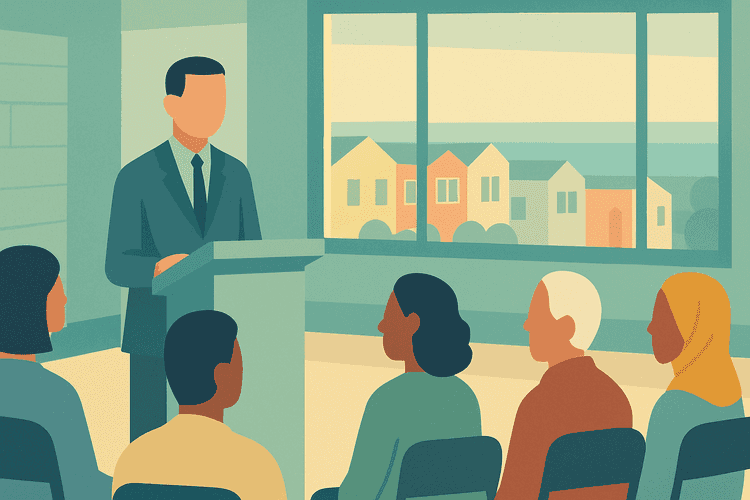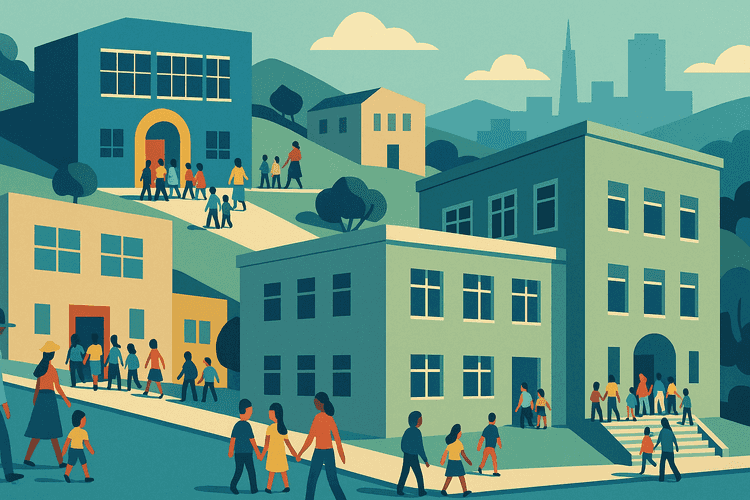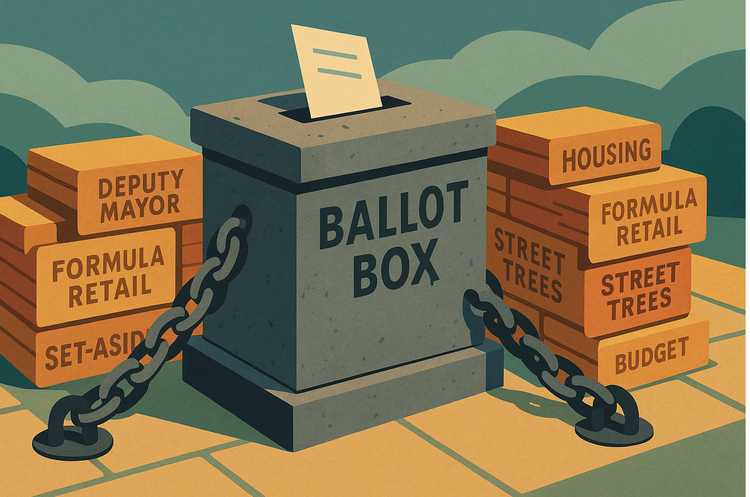What You Need To Know
Here’s what happened around the city for the week of November 30, 2025:
- Alan Wong Appointed to Sunset Supervisor
- Derrick Lew Named San Francisco Police Chief
- SF Teachers Union Votes to Authorize Strike Vote
- SFUSD prepares for major school reorganization
- Family Zoning Plan Approved
Recent & upcoming openings:
- Opening 1
Research:
- Laws Cast in Stone: The Problem with Ballot Measures
Alan Wong Appointed to Sunset Supervisor
Published December 4, 2025

https://growsf.org/news/2025-12-04-alan-wong-sunset-supervisor/
The Facts
Alan Wong is the new District 4 Supervisor, replacing Beya Alcaraz, who resigned after one week in office, and Joel Engardio, who was recalled by voters in September 2025.
Wong is a lifelong Sunset resident, has served in the Army National Guard since 2009, and was on the Board of anti-crime group Stop Crime SF. Most recently, he was elected to the City College of San Francisco Board of Trustees in November 2020 and served two terms as the board's president. Wong had to resign from City College to accept his new role as supervisor.
One day after being sworn in, Wong joined a 7–4 Board majority to approve Lurie’s “Family Zoning” plan.
The Context
Mayor Lurie revamped his vetting process after the Alcaraz episode, requiring a detailed questionnaire and broader community outreach before choosing Wong.
The former Supervisor, Joel Engardio, was recalled over backlash to 2024’s Proposition K, which closed the Upper Great Highway to cars to create the Sunset Dunes park. Wong opposed Prop K and will now be responsible for navigating its aftermath and any proposed compromises.
The GrowSF Take
Wong's history as a member of Stop Crime SF and his military service all indicate he will make public safety a keystone of his tenure. And his experience on the City College board shows he understands the importance of good governance and fiscal responsibility, alongside good education.
We don't know exactly where Wong stands on housing and small business, but Wong’s vote for Family Zoning is a very encouraging sign that the Sunset’s new supervisor understands that more homes are essential to keeping families in San Francisco.
Given everything the Sunset has gone through this year, Wong should work closely with the community and take time to listen rather than escalate fights over big changes. He still has to run in June and again in November to keep his seat, so building trust now will put him in a stronger position to pursue larger policy goals later.
Derrick Lew Named San Francisco Police Chief
Published December 4, 2025

https://growsf.org/news/2025-12-04-derrick-lew-named-sf-police-chief/
The Facts
Derrick Lew is San Francisco’s next police chief. Mayor Lurie chose the 52-year-old, 20-year SFPD veteran—who led the city’s crackdown on illegal drug markets and survived a 2006 Bayview shootout that earned him a medal of honor—from a shortlist of three finalists out of 34 applicants provided by the Police Commission.
Lew will replace Interim Chief Paul Yep after Bill Scott’s May resignation, with Yep expected to stay briefly as an advisor during the transition.
The Context
Lew’s most recent assignment was overseeing the Drug Market Agency Coordination Center (DMACC), a multi-agency task force created to target open-air drug markets in the Tenderloin and SoMa that reported thousands of arrests and hundreds of kilos of seized narcotics in its first year.
The GrowSF Take
Hiring a new chief should have been fast and straightforward, but San Francisco has a uniquely dysfunctional process: the Mayor doesn't actually get to pick the chief directly. Instead, the Police Commission prepares a shortlist of three finalists from which the mayor must choose.
Under former Mayor London Breed, Chief Scott was largely insulated from any threats of replacement. Had Mayor Breed fired him, a defund-the-police oriented Police Commission would have given her worse options. But after voters elected a more moderate-leaning Board of Supervisors, Mayor Lurie was able to secure the removal of Commissioner Carter-Oberstone and then seated new commissioners, giving the mayor a working majority on the seven-member Police Commission. This majority presented options the mayor actually wanted, and thus we have Chief Lew. that produced the finalist slate Lew emerged from.
San Franciscans deserve streets that are safe, clean, and fair. Lew’s background in targeted drug enforcement and inter-agency coordination fits the city’s biggest public-safety challenges, but success must be measured, not assumed. We expect to see improving metrics: declining overdoses, faster 911 response times, more officers, revamped officer recruitment, and more cases solved.
SF Teachers Union Votes to Authorize Strike Vote
Published December 4, 2025

https://growsf.org/news/2025-12-04-sf-teachers-union-strike-vote/
The Facts
United Educators of San Francisco (UESF) members voted in favor of holding a strike vote after nearly nine months of contract talks with the San Francisco Unified School District (SFUSD), according to Mission Local. That vote happened among a subset of UESF members who attended a meeting at Balboa High School on Dec. 3, not UESF’s roughly 6,500 members; the union has not released turnout numbers.
This vote does not call a strike. It is the first of two required approvals before one may happen. The union is seeking dependent health coverage, raises of 14% for classified staff and 9% for certificated staff over two years, a new special‑education workload model, among other demands. SFUSD’s September “packaged proposal” offered a 2% raise over two years while cutting some benefits, though most of the cuts came from reducing administrative overhead, closing open but unfilled positions, and natural attrition from retirements.
The Context
After years of mounting deficits, the Board adopted a 2025–26 budget with at least $113.8 million in cuts and plans further reductions to close a projected $103 million gap in 2026–27, per the district’s budget overview.
This year, as part of the cuts, SFUSD was able to avoid laying off 151 teachers.
SFUSD is still subject to fiscal oversight by the California Department of Education, and is subject to state intervention until the state deems it financially fit. Until then, even if the district agrees to UESF’s demands, state regulators may determine the new expenses are unsustainable and reject the union's contract.
The GrowSF Take
Students should not pay the price for adults' failures. This is a dangerous gamble for UESF to make, risking a strike that would disrupt learning for over 50,000 students in a district already struggling to meet their needs, and their demands are likely to be rejected by state regulators anyway.
SFUSD prepares for major school reorganization
Published December 3, 2025

https://growsf.org/news/2025-12-03-sfusd-prepares-major-school-reorganization/
The Facts
San Francisco's school district has about 14,000 empty seats across 125 schools, and that is expected to grow to nearly 19,000 by 2032. The district had been gaining students for about a decade, but enrollment fell dramatically during the pandemic from about 61,000 students to about 55,000, where it remains today. This has resulted in a large number of under-enrolled schools which are expensive to maintain and don't serve students well.
School Board President Phil Kim’s draft “Strong Schools Resolution” would direct Superintendent Maria Su to bring a reorganization plan, which may include school mergers, to the Board by August 2026, for implementation in the 2027–28 school year, and to explicitly promise clearer communication than the 2024 attempt to merge schools.
The Context
SFUSD’s post‑pandemic enrollment story is less about a free‑fall and more about a new, consistently lower level: the district serves roughly the same number of students today as it did in 2009, but on a system that was built for far more, with fixed costs in staffing, utilities, and maintenance spread across too many campuses, too few students, and too few state tax dollars. To escape state fiscal oversight and avoid receivership, the Board adopted a 2025–26 budget that cuts more than $110 million and paired it with a Fiscal Stabilization Plan that calls for tens of millions more in reductions in 2026–27, according to SFUSD’s own budget and solvency updates.
Last year’s aborted closure list highlighted small, under‑enrolled campuses like El Dorado Elementary in Visitacion Valley, Harvey Milk Civil Rights Academy in the Castro, and June Jordan School for Equity near the Excelsior, all of which have seen their enrollments fall by a third to half from earlier peaks, based on state enrollment data summarized by The Standard. Even with overall district enrollment holding around 55,000, these individual school‑level declines are what make consolidation hard to avoid.
The GrowSF Take
San Francisco’s kids need stable, academically strong schools more than they need every existing building to stay open. Keeping dozens of half‑empty campuses afloat diverts money from teachers, core classes, and student support into overhead and maintenance. We support a transparent, data‑driven reorganization that uses clear criteria: enrollment trends, facility quality, academic performance, all while guaranteeing affected students a better‑resourced school, and reasonable commute options.
Done well, consolidation can turn today’s thinly stretched offerings into stronger programs with more electives, counselors, and extracurriculars.
Family Zoning Plan Approved
Published December 2, 2025

https://growsf.org/news/2025-12-02-family-zoning-approved/
The Facts
San Francisco has a new zoning map that will welcome tens of thousands of new families and preserve $100 million in state Affordable housing funds.
The Board of Supervisors voted 7–4 to approve Mayor Daniel Lurie’s “Family Zoning” plan which covers about 60% of the city, largely northern and western neighborhoods. Along key transit corridors on the west side, height limits will rise into the 6–10‑story range, with some parts of Lombard and Van Ness allowing taller buildings.
The Context
Family Zoning is San Francisco’s answer to state law requiring the city to plan for more than 82,000 new homes by 2031 in its certified Housing Element. About 36,000 of those units must come from rezoning “high‑resource” western and northern neighborhoods by January 2026, or the city risks losing some local control and state housing and transit funds. The plan builds on former Mayor London Breed’s reforms.
The GrowSF Take
This vote is historic. It is the first meaningful residential upzoning since the city was downzoned on September 18, 1978 -- nearly 50 years ago!
The Environmental Impact Report of the 1978 downzoning was prescient:
The proposed amendments would reduce the allowable density in many neighborhoods, so that, approximately 180,000 estimated fewer housing units could legally be built in San Francisco. As a result the demand for housing in certain neighborhoods may not be accommodated. Prices and rents may be bid upward as a result of limited supply in some neighborhoods.
If housing prices and rents are forced higher than would normally be expected, adoption of the proposed amendments may displace low- and moderate-income and elderly households.
In short: policymakers knew that downzoning would worsen affordability and displacement, and that is exactly what happened over the next fifty years. On tuesday, December 2, 2025, the Board of Supervisors finally took a step to reverse that damage.
Recent & upcoming openings
A great city is constantly changing and growing, let’s celebrate what’s new!
Restaurant title here
restaurant description
Research
Laws Cast in Stone: The Problem with Ballot Measures
Published December 1, 2025

https://growsf.org/research/2025-12-01-laws-cast-in-stone/
We pass a lot of ballot measures, which means a lot of laws are set in stone. San Francisco's Charter makes voter-approved measures exceptionally difficult to alter or repeal. In fact, any law adopted by voters cannot be amended, fixed, or undone by elected leaders.
This legal rule (Charter Article XIV, Section 14.101) means that policies enacted via ballot initiative are effectively permanent unless another expensive campaign is run for a citywide vote. Even minor corrections or updates to voter-adopted laws require costly ballot measures, so outdated provisions tend to linger. A recent SPUR report notes that the path of least resistance to fixing an error is usually to leave it in place or add new layers on top.
San Francisco's heavy use of direct democracy contributes to city hall rigidity. Between 2013 and 2022, San Francisco voters considered 115 local ballot measures—more than twice as many as in San Diego, the next closest California city. Notably, about 70% of those SF measures were put on the ballot by city officials themselves, which we criticized in "Too Many Ballot Measures."
In short, San Francisco's Charter and initiative process give voters immense power over policy, but at the cost of flexibility: once voted on at the ballot box, policies are virtually permanent until/unless the entire city votes again to change them.
Voter Mandates and Set-Asides Limit Budget Flexibility
Voter-mandated spending requirements (often called "baselines" or "set-asides") heavily constrain San Francisco's budget.
Between 1994 and 2022, the percent of the city's General Fund budget tied up in voter-mandated set-asides doubled—from 15% to 30%. A 2024 Civil Grand Jury report found that over 30% of the city's General Fund budget is tied up by more than 20 voter-approved spending mandates. By contrast, all other cities and counties in California combined have just 10.
These voter-adopted set-asides guarantee funding for certain programs regardless of other needs. While it may sound great to dedicate millions of dollars to maintaining street trees, when the City is facing a huge budget deficit, it'd be nice to be able to reallocate that money to fund other priorities like Muni and the police.
The San Francisco Controller's Office explains that while set-asides tend "to increase certainty regarding year to year funding levels", they also "limit the financial flexibility of elected policymakers." As more of the budget is pre-allocated by law, any necessary cuts or reallocations must come from an ever-shrinking portion of the discretionary budget.
City oversight bodies have flagged this rigidity as a growing problem. The Civil Grand Jury noted that "voter-mandated spending (set-asides) significantly affects management of the city's budget", and it urged a dedicated analysis of how to handle these constraints.
While San Francisco's myriad voter-imposed budget mandates provide certainty for certain services, collectively they force a shrinking portion of the city budget to absorb 100% of any budget deficit while limiting budget flexibility along the way.
Outdated Mandates
A recent example of structural dysfunction (and clever workaround) is San Francisco's prohibition on Deputy Mayors. In most major cities, mayors appoint deputy mayors or similar managers to coordinate broad policy areas—New York City and Los Angeles, for instance, both employ deputy mayors. San Francisco, however, banned deputy mayors with a 1991 ballot initiative: Proposition H.
The ban was driven by "anger over the high salaries of deputy mayors," but its long-term effect has been to hamstring the Mayor's Office, stymie cross-departmental coordination, and make government less effective. Rather than a team of deputy mayors overseeing clusters of departments, the Mayor was forced to rely on just their Chief of Staff.
Mayor Lurie, for his part, figured out a workaround in 2024 by creating several Policy Chiefs within the Mayor's Office to oversee key areas like housing, public safety, and economic development. But these Chiefs lack any legal authority, and the Mayor's Office still faces challenges coordinating across siloed departments and commissions.
Given that the city seems to be running much better with these Policy Chiefs in place, it's clear that the 1991 ban on deputy mayors is an outdated impediment to effective governance. But it's still the law of the land, and properly fixing it will require another expensive citywide vote.
City leaders today recognize that some well-intentioned mandates from a bygone era are now acting as impediments to good government. But meaningful reform will ultimately require asking the voters to "clean up" the charter by removing or modernizing entrenched provisions.
Good Governance Needs Flexibility, and Fewer Ballot-box Mandates
Governance works best when there's room to adapt. That's why good-government experts like SPUR urge San Francisco to "resolve issues through leadership rather than at the ballot". Voters should set broad direction and priorities, but then let the Mayor, Board of Supervisors, and city departments work out the details, and adjust on the fly as needed. We elect our leaders to problem-solve and make informed decisions. They can't do that effectively if every adjustment requires a citywide vote to undo an old mandate.
San Francisco needs to regain some flexibility in its laws. When policies prove unworkable or circumstances evolve, our officials should be able to course-correct without waiting for the next election. That doesn't mean shutting voters out, but it does mean only using the ballot box for big-picture guidance, not minute administrative rules. And that probably looks like making it hard to put ballot measures on the ballot.
Empower Elected Representatives
At the end of the day, we elect our Mayor and Supervisors to govern, and we should let them do it. That means shifting away from direct democracy at the ballot box as the default and back toward representative democracy.
If the Mayor and Board are empowered to actually govern, and can be expected to negotiate solutions instead of waging ballot campaigns against each other,voters can then judge them on their performance. We'll know whom to credit or blame. Right now, responsibility is often muddled: was it the voters' fault or the officials' fault that something went wrong?
Returning decision-making power to our elected officials will improve the City's governance and clarify accountability. And if we don't like the job they're doing, we can vote them out, rather than trying to micro-manage the City via propositions.